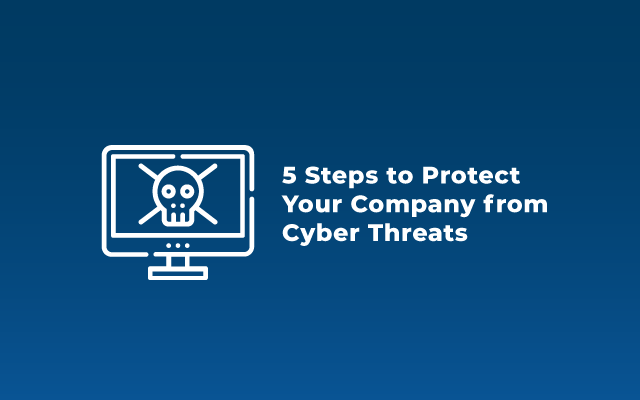Articles /
5 Steps to Protect Your Company from Cyber Threats

When it comes to protecting your business from cyber threats, employ a people-centric security approach. This ensures that the first line of defense, your device end-users, are empowered to detect and prevent threats rather than increase risk due to employee negligence. It is also important to set up firewalls, utilize VPNs, and encrypt sensitive information as standard protocol.
1. Implement Strong Security Measures
When it comes to protecting your business from cyber threats, employ a people-centric security approach. This ensures that the first line of defense, your device end-users, are empowered to detect and prevent threats rather than increase risk due to employee negligence. It is also important to set up firewalls, utilize VPNs, and encrypt sensitive information as standard protocol.
Something to not overlook is remote work vulnerabilities. Make it clear to employees that they should utilize private hot spots rather than public Wi-Fi when out of the office. At home offices and in headquarters, the Wi-Fi network should remain hidden, and password protected. To take things a step further, create policies around the selectivity of information stored in company databases. Make sure permissions levels are set to restrict access and that multifactor authentication is used properly. These tips are a few actionable items that can greatly increase your organization’s protection from cyber threats.
2. Create a Cybersecurity Incident Response Plan
It is important to involve your IT team, a cross-functional cybersecurity task force, and your Managed Security Services Provider (MSSP) in the critical step of developing a cybersecurity incident response plan. A documented, sometimes “living” plan has distinct phases designed to help your organization recognize and deal with a cybersecurity incident like a network breach or cyber-attack.
In addition to an incident response plan being a PCI DSS requirement, Requirement 12 specifies steps that businesses must take relating to their cybersecurity incident response plan. This includes annual testing, 24/7 incident task force assignment, training, alert system implementation, and even a process to update and manage the incident response plan documentation and policies.
Cybersecurity Incident Response Plan Phases
- Preparation
- Identification & Detection
- Containment & Triage
- Investigation & Analysis
- Containment & Eradication
- Recovery
- Post Incident Follow Up
3. Stay Current on Cybersecurity Threats
The types of vulnerabilities, attacks, and cybersecurity threats evolve rapidly and can impact your cyber security through multiple points of entry into your system. A good way to keep current with cybersecurity news is to follow security professionals, reporters, and influencers. Get the RSS feed from your favorite MSP or MSSP. Keep an eye on what’s trending on Twitter for cybersecurity. Attend live events and listen to recordings put on by companies that are in the infosec and cybersecurity arena. Listen to podcasts. There are some great podcasts that cover cybersecurity topics such as new age malware, phishing schemes, vulnerability landscape, and actions of bad actors or known hacking groups. Lastly, be proactive. You can customize your own real-time alerts to stay in the loop.
4. Data Backup and Disaster Recovery Contingencies
Backing up company data increases the likelihood that with a cyber-attack or ransomware attack the data will not be lost completely. The main backup processes used to protect files are full, incremental, and differential methodologies. It would be a good idea to dive in to know the differences, and which would be the best fit for your company. It is critical to have a data backup strategy for on-premises or cloud that accounts for disasters and bad actors. This may involve including a hard copy of procedures, curating a priority restore list, regularly testing isolated backup systems, end-of-life disposal strategy, and standardizing backup systems. Importantly, create a routine for regularly updating your software.
5. Security Awareness Training
The first line of defense is the employees of your company. It is a proactive approach to empower the end-users of your devices to spot when things seem off. Security awareness training can be a powerful tool to augment your IT or MSSP’s work. Use training as a level field to establish practices that protect your company from cyber-attacks. This is where you can demonstrate how to spot poor digital hygiene, scrutinize an email from an untrustworthy source, and provide guidelines for resolving issues. Do your employees know what to do if they suspect that their device is infected with a virus? There are great educational platforms out there that include simulated phishing attacks to drive home lessons. Use security awareness training to define policies that outline how situations are handled, including policy infringement. By investing in your employees, you can evoke a healthy cybersecurity culture in your organization.